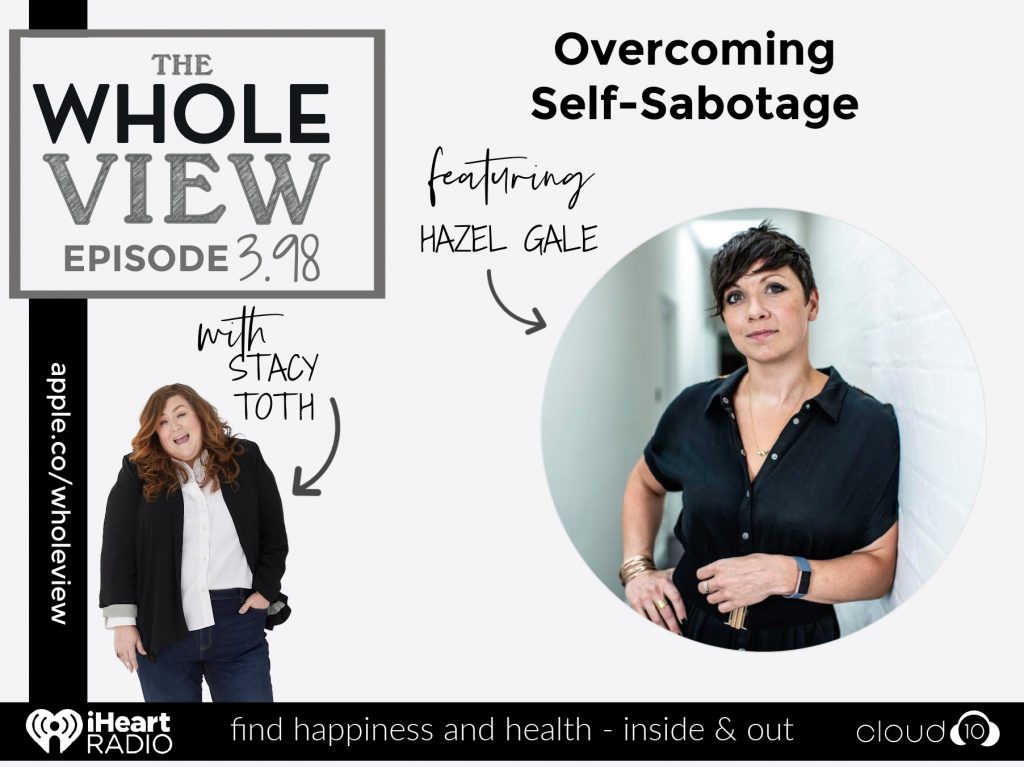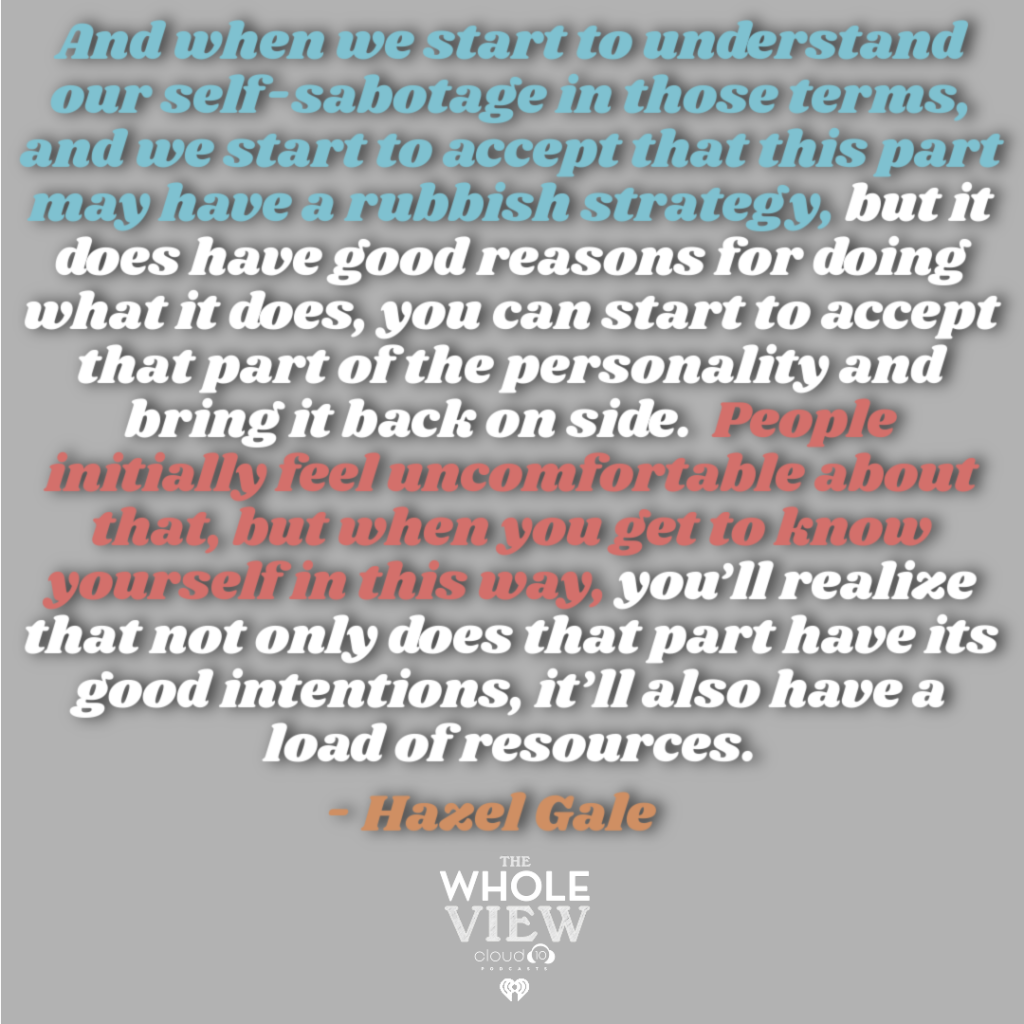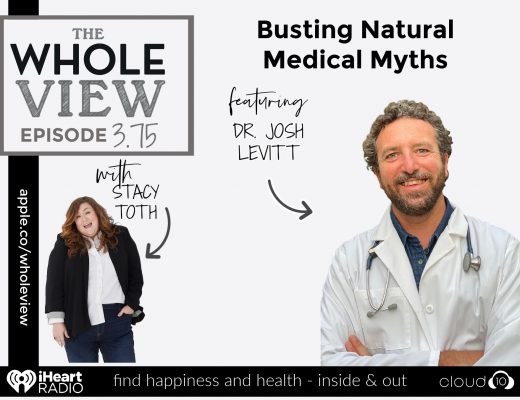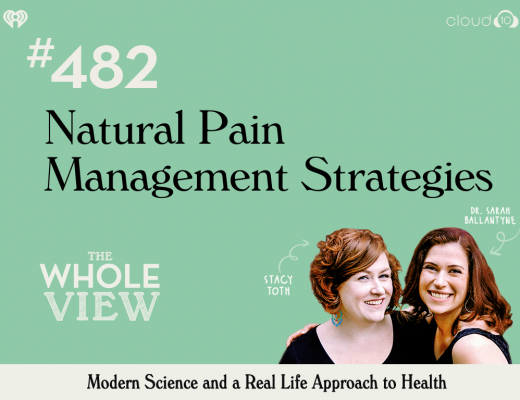Former athlete turned therapist and author, Hazel Gale, shares their experience with burnout, an ADHD diagnosis, and learning from self-sabotage. Stacy and Hazel discuss identifying your monsters within and finding self-compassion through the process.

Find Hazel:
If you enjoy the show, please leave a review. Letting people know on iTunes or however you listen that it’s worth their time could change someone’s life!

Key Takeaways
Introductions
- Hazel Gale is a master practitioner of cognitive hypnotherapy, a former world kickboxing champion and a multiple national and open European ABA boxing-title winner. Following a physical and psychological burnout during her first few years of competitive fighting, cognitive hypnotherapy helped Hazel to rebuild her physical strength and achieve a balanced, healthy emotional state.
- Empowered by the changes she made for herself, Hazel trained as a therapist so that she could devote her time to helping others win their own emotional battles. She currently practices in London and specializes in performance-related issues and the pursuit of creative and professional goals.
- Now working full-time on her app Betwixt, Hazel remains dedicated to her mission to help others win their own emotional battles in creative and engaging ways.
Overcoming Self-Sabotage
ADHD in Biological Females
- Hazel created Betwixt to help those with ADHD, among other things. Given Hazel’s background, Stacy found research that sports and other physical activities help improve symptoms. Specifically, a 2020 study found that biologically female individuals “consistent participation in organized sports reliably predicted improved behavior and attentiveness in girls with ADHD.
- Additionally, consistent participation in organized sports reliably predicted improved behavior and attentiveness in girls with ADHD, according to a recent study of elementary school students active — and not active — in extracurricular activities. No such association was found for boys with ADHD. (3)
- Stacy talks a lot on the show about Matt and her male children with ADHD. But it presents so differently in biological females. According to the CDC boys are far more likely to receive a diagnosis ofADHD— not necessarily because girls are less prone to the disorder but because in girls ADHD presents differently. The symptoms are often more subtle, and they don’t fit the stereotype.
- Research and clinical practices are built around male presentations of ADHD, and science has historically paid little attention to female manifestations and impairments. “As a result, many girls and women still battle to receive proper referral, diagnosis, and treatment – and face dire consequences when these medical rights are denied. To right these gender wrongs, it’s time to seriously rethink the way ADHD is assessed, diagnosed, and treated.” (4)
Mind Monsters in Self-Sabotage
- Stacy points out it’s important to recognize what ADHD looks like for the “inattentive day dreaming underachievers” as one article she read called them vs. the traditional impulsivity associated with long centered and overvalued male presentations of ADHD as it plays a huge part in self-sabotage. Hazel’s book, The Mind Monster Solution focuses on variations of this – and we know ADHD classically has impairments like distractibility, executive dysfunction, and emotional dysregulation which all would be part of that “Mind Monster”.
- Hazel defines Mind Monsters as the parts of the personality that people automatically fear, resist and attempt to hide from the world. Our monsters include:
- Unwarranted fear, anxiety or phobias
- Harbouring long-term resentment of other people or external circumstances
- Consistently putting the needs of others before your own
- Procrastination, underachieving or anything else that feels like avoidance of a potentially beneficial challenge
- A recurring feeling of fraudulence or failure, no matter how legitimate your achievements might look on paper
- Regular negative or self-defeating thoughts such as ‘I can’t …’ or ‘I won’t be able to …’; these could be specific, like ‘I’m no good at maths’, or much more general, like, ‘I’m just not good enough’
- Over- or under-eating (or any kind of eating disorder)
- Self-harm, self-pity or physical neglect
- Withdrawal from social circles
- Addictions and dependencies like alcoholism, drug addiction, gambling,
- overspending or work addiction
- Reluctance to seek or accept help
- Doing things that sabotage your relationships
- Dissociation from emotions (as in, not feeling much of anything)
- Frequent, poorly timed injury or illness (5)
Cognitive Hypnotherapy
Monster moments (self-sabotages) are nothing more than unwanted trance behaviors. The goal of our work, as we see it in cognitive hypnotherapy, is therefore not to hypnotize people in order to solve their problems, but to help them ‘de-hypnotise’ (or perhaps re-hypnotise) themselves whenever things aren’t going exactly as they’d wish.So, we really don’t need a moustachioed, pocket-watch-swinging performer if we want to make a difference to the way that we think. We are our own hypnotists. We just need to learn how to make effective suggestions. (5)
- Stacy notes that in Hazel’s book, they focus on so many mental and physical benefits through cognitive hypnotherapy. Hazel notes that she has made massive changes thanks to hypnotherapy because “trance is something that every mind can achieve just by watching a movie, reading a book or having a deep conversation”.
- Stacy say the the examples of driving and eating are so relatable to the “Monster moments” of self-sabotage that are nothing more than unwanted trance behaviors we need to wake up from:
- “In cognitive hypnotherapy we have a different understanding of hypnosis to that of some more traditional hypnotic practices (like stage hypnosis). Trance can be defined as a state of mind in which unconscious rather than conscious thinking determines behavior, and where a person’s thoughts are easily influenced by external input…These days, we know a lot more about the mind. It’s now understood that complete conscious control over our behavior is a rarity (if possible at all)… Whenever an experienced driver makes the journey to work in their car, they do not need to consciously think about signaling or changing gear… They’re in their ‘driving trance’, and assuming they get safely to where they need to go, this will be an effective and useful hypnotic state.”
Next Steps
- Based on her experience working with clients and personally, Hazel has some recommendations for overcoming the story well tell ourselves or the facade of strength and denial:
- THE IMPORTANCE OF STORYTELLING FOR EMOTIONAL RESILIENCE AND MENTAL HEALTH: Discuss the ways in which play and narrative can create the types of creative and immersive – yet low-stakes – environments that enable us to explore novel possibilities, rehearse our responses to challenge, and adopt new, healthy perspectives on life.
- THE POWERS AND PITFALLS OF SELF-REFLECTION: Studies show that the development of self-awareness can lead to greater confidence, improved relationships, increased creativity and much more, but the way people tend to engage in this work can sometimes do more harm than good.
- THE IMPORTANCE OF SELF-COMPASSION: The concept of self-compassion may sound a little fluffy, but a growing body of research shows that it leads to positive mental health, improved physical health, decreased psychopathology, increased wellbeing and resilience, and more. Dr. Kristen Neff breaks self-compassion down into three components, all of which play key roles in the Betwixt narrative. (5)
- We tend to self-distance and get so wedded to our own negative stories; but there is always another perspective:
- What am I thinking (not analyzing, just noticing) and feeling (physical experience of your emotions)?
- What’s the story I’m telling myself? What’s my monster story?
- Is there better story? What if I didn’t believe that thing?
Studies, References & Products
- Females with ADHD: An expert consensus statement taking a lifespan approach providing guidance for the identification and treatment of attention-deficit/ hyperactivity disorder in girls and women, BMC Psychiatry
- Child Mind Institute: How Girls With ADHD Are Different
- ADDitude: Study: ADHD Symptoms in Girls Diminish with Extracurricular Sports Activity
- ADDitude: ADHD in Women and Girls: Why Female Symptoms Slip Through Diagnostic Cracks
- The Mind Monster Solution by Hazel Gale
- Self-Compassion: The Proven Power of Being Kind to Yourself by Kristin Neff
Sponsors
- Lumedeodorant.com | Use code WHOLEVIEW to get $5 off a starter pack
- Beautycounter.com/StacyToth | Get 20% off your first order with code CLEANFORALL20
Want more info on our Real Life? Healthy recipes, parenting tips, and general lifestyle stuff goes out in our Real Everything newsletter, join here.
So never want to miss a post, sale, or deal? Join my Healthy Inside & Out e-mail list for more info on non-toxic living and safer skincare!




